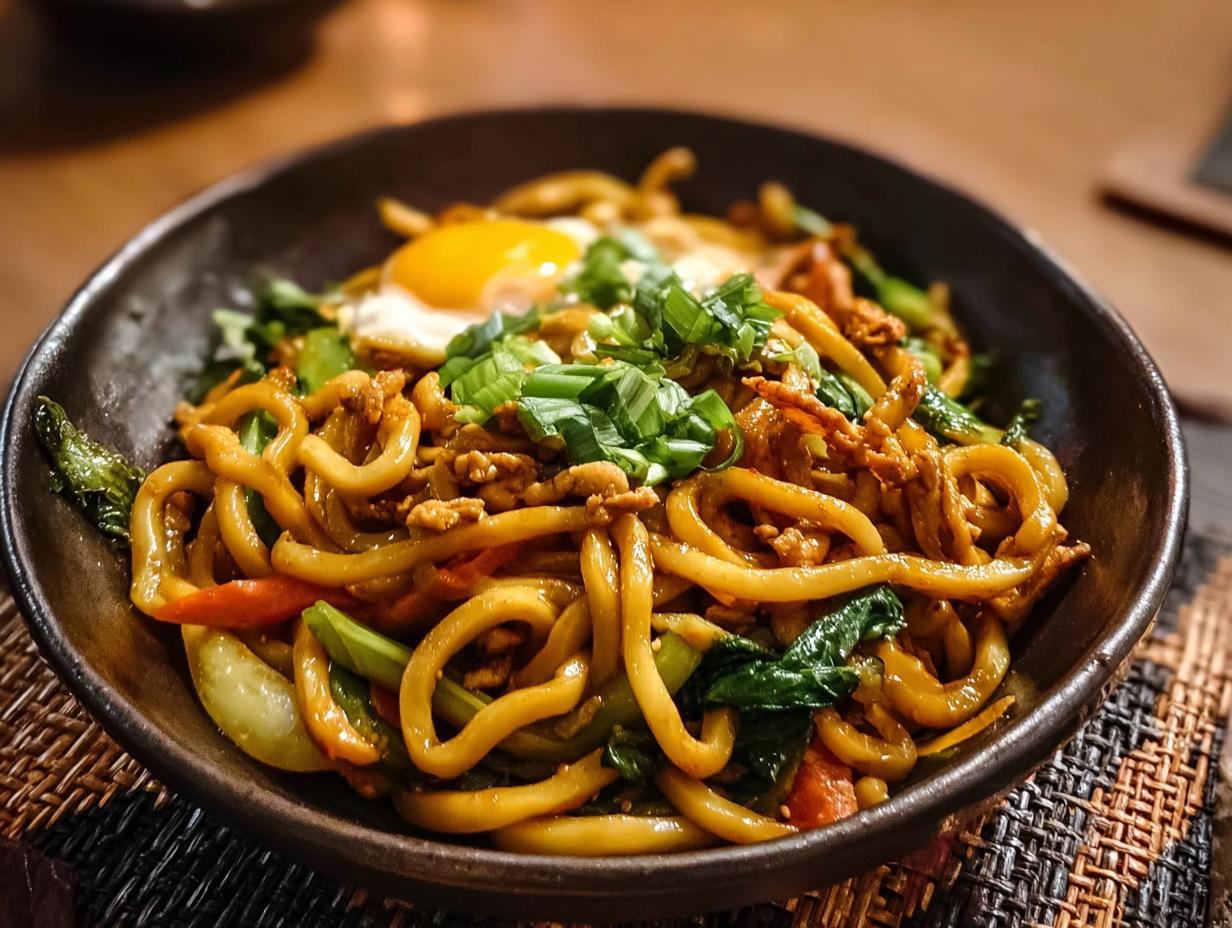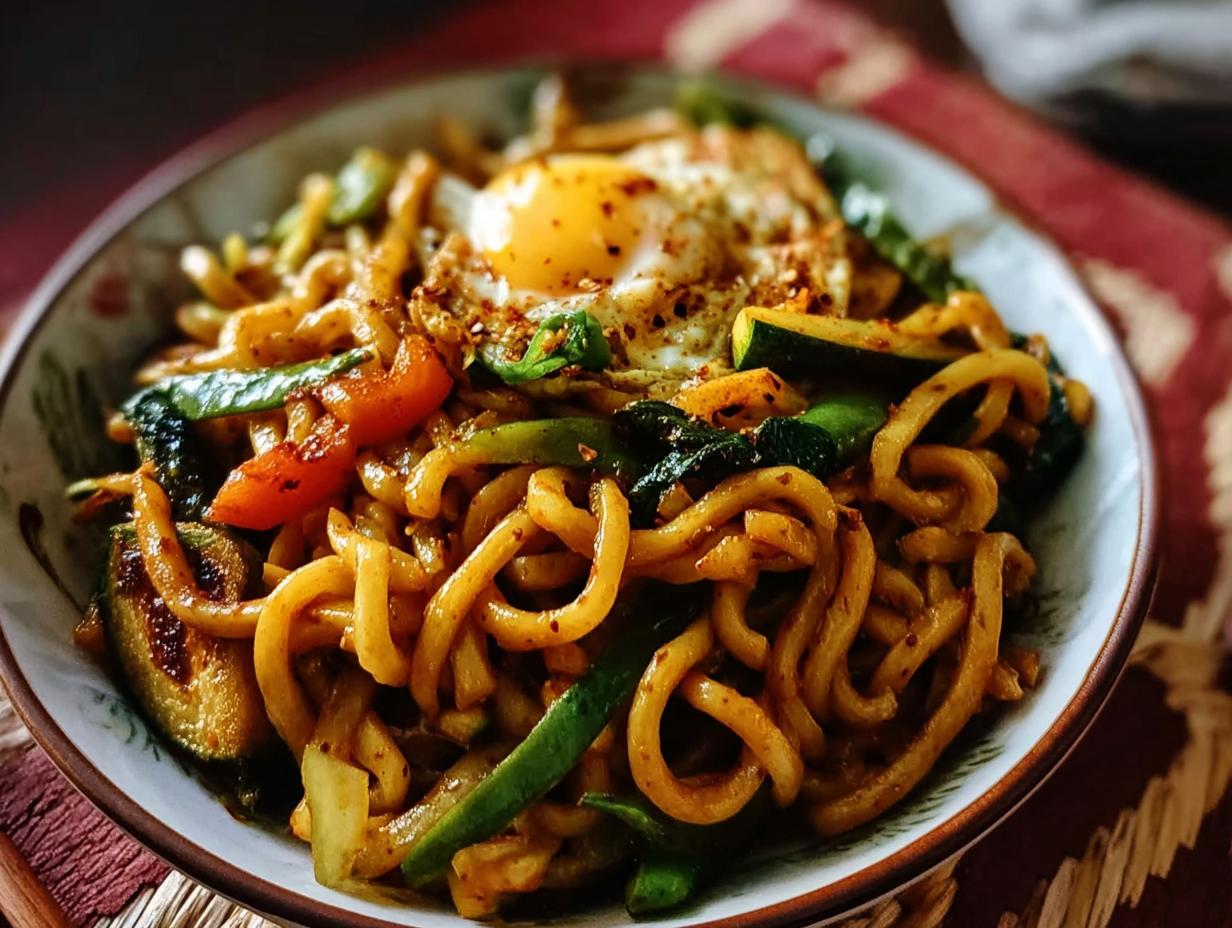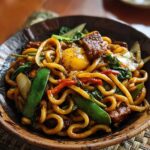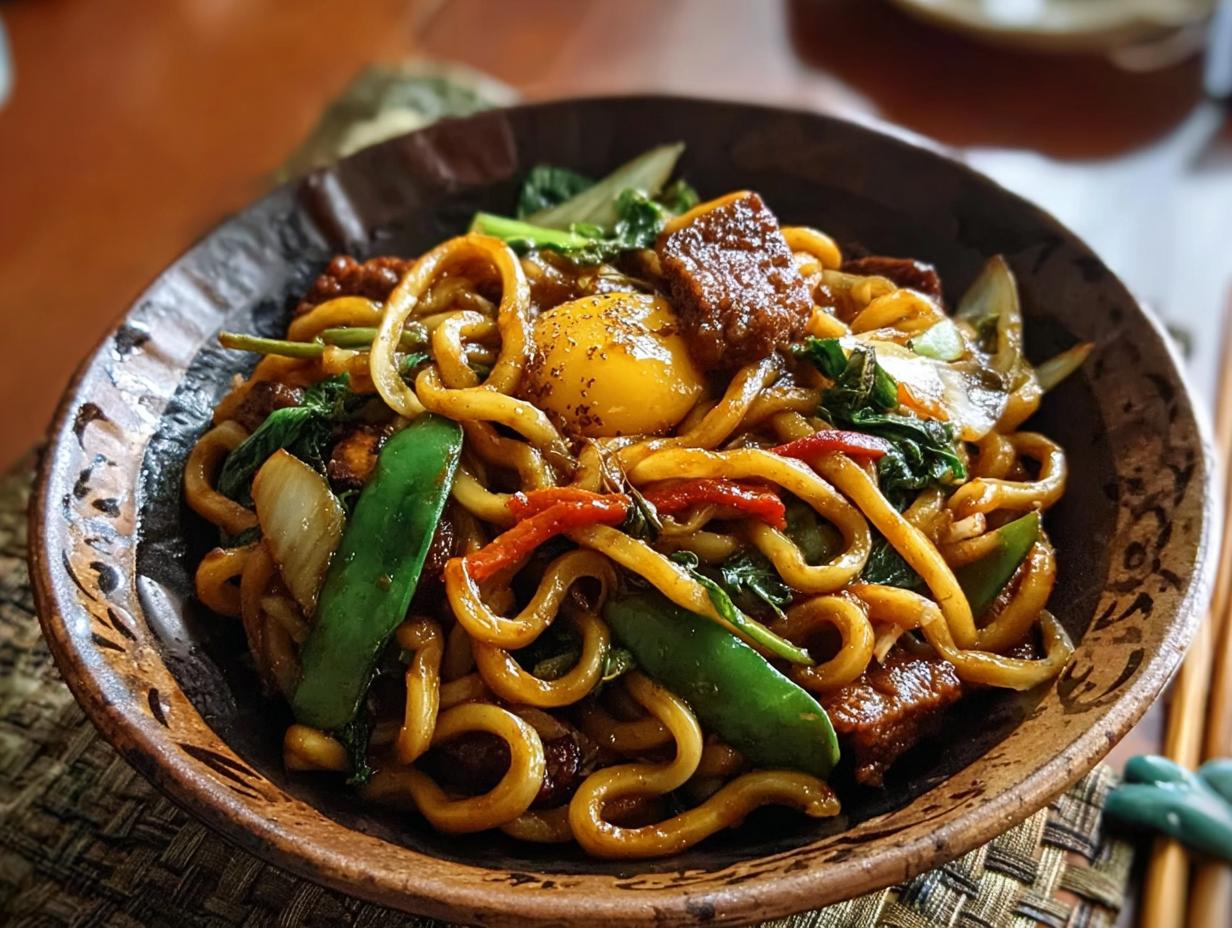Japanese Yaki Udon has a way of warming me up from the inside out, especially on a chilly evening. I still remember the first time I tasted it at a tiny Tokyo eatery – the thick, chewy noodles coated in a deeply savory sauce, mingling with crisp vegetables and a hint of garlic. It was a revelation! This simple dish, often called Japanese stir-fried noodles, is incredibly adaptable and satisfying. The aroma alone, a mix of soy, sesame, and stir-fried goodness, is enough to make your mouth water. Let’s get cooking this delicious udon stir fry recipe!
Why You’ll Love This Yaki Udon Recipe
Get ready to fall in love with this incredible noodle dish! It’s more than just a meal; it’s a delightful culinary experience.
- Incredibly Quick: This easy yaki udon comes together in under 30 minutes, perfect for busy weeknights.
- Amazingly Versatile: Feel free to swap out vegetables or proteins to suit your tastes and what you have on hand.
- Deeply Flavorful: The irresistible, savory sauce coats every strand, creating truly savory udon noodles you’ll crave.
- Comfort Food Perfection: The thick, chewy udon noodles are incredibly satisfying and comforting.
- Simple Steps: Even if you’re new to Japanese cooking, the instructions are straightforward and foolproof.
- Adaptable for All: Easily make this a vegetarian or vegan dish by adjusting the protein and sauce ingredients.
- Authentic Taste: Enjoy the genuine flavors of a traditional Japanese stir-fry right in your own kitchen.
Authentic Yaki Udon Ingredients
Gathering these yaki udon ingredients is the first step to creating this delicious Japanese stir-fry. You’ll find that the components work together beautifully to create that signature savory flavor and satisfying texture.
- 2 portions fresh udon noodles (approx. 400 grams) – the star of the show, providing that wonderfully chewy bite. Fresh udon is preferred for its superior texture.
- 2 tbsp neutral oil – like vegetable or canola oil, perfect for stir-frying without imparting its own flavor.
- 2 garlic cloves, minced – adds a pungent aroma and depth to the sauce.
- 1/4 cup yellow onion, thinly sliced – brings a subtle sweetness and tender bite when stir-fried.
- 1/2 cup cabbage, thinly sliced – offers a pleasant crunch and absorbs the sauce wonderfully.
- 1/4 cup carrot, julienned – adds a touch of sweetness and color.
- 1 green onion, chopped (reserve some for garnish) – provides a fresh, mild onion flavor.
- 1 tbsp soy sauce – the salty base of our sauce.
- 1 tbsp oyster sauce – adds a rich, umami depth and slight sweetness, crucial for authentic flavor.
- 1 tsp dark soy sauce – for color and a more complex, less salty umami note.
- 1 tsp sugar – balances the saltiness and enhances the savory notes.
- 1/2 tsp sesame oil – adds a nutty aroma and flavor that signifies traditional Japanese cooking.
- Optional: cooked lamb strips or sliced beef sausage – for added protein and heartiness.

How to Make Japanese Yaki Udon
Let’s dive into how to make yaki udon! This recipe is designed to be straightforward, letting you create that authentic, delicious noodle dish right in your kitchen. Get ready for a quick and satisfying meal.
- Step 1: Prepare the udon noodles. If you’re using fresh udon, gently separate the strands under warm running water to loosen them up. For frozen udon, boil them for about 1-2 minutes until they’re soft, then drain and give them a quick rinse with cold water. This prevents them from sticking together. Set them aside for now.
- Step 2: Sauté the aromatics and vegetables. Heat a large skillet or wok over medium-high heat and add your neutral oil. Once shimmering, toss in the minced garlic and thinly sliced onion. Stir-fry for about 30 seconds until you can really smell that garlic becoming fragrant. Add the sliced cabbage and julienned carrots to the pan. Continue to stir-fry for another 2-3 minutes, just until the vegetables are tender-crisp. If you’re adding optional meat like lamb strips or beef sausage, now’s the time to toss them in to warm through.
- Step 3: Combine and coat with sauce. Add the prepared udon noodles directly into the skillet with the vegetables and any optional meat. Toss everything together to combine. In a small bowl, whisk together the soy sauce, oyster sauce, dark soy sauce, sugar, and sesame oil to create your flavorful stir-fried udon with sauce. Pour this sauce mixture evenly over the noodles and vegetables. Stir continuously for about 2-3 minutes, making sure every strand of udon is beautifully coated. You’ll notice the noodles starting to caramelize slightly, which adds a wonderful depth of flavor.
- Step 4: Finish and serve. Turn off the heat. Stir in the chopped green onions, reserving a few for garnish. Give it one final toss. Serve your delicious homemade Japanese Yaki Udon immediately. Garnish with the reserved green onion slices for a fresh finish and an extra pop of color. Enjoy this incredibly satisfying noodle dish!
Pro Tips for the Best Japanese Yaki Udon
Want to elevate your noodle game? These simple tips will help you achieve restaurant-quality results every time you make this dish.
- Always use fresh or frozen udon; dried udon can become mushy when stir-fried.
- Don’t overcrowd the pan! Cook in batches if necessary to ensure the noodles and vegetables stir-fry properly instead of steaming.
- Get your wok or skillet screaming hot before adding ingredients for that perfect char and flavor.
- Taste and adjust the sauce before adding it to the noodles – a little extra sugar or soy sauce can make all the difference.

What’s the secret to perfect Japanese Yaki Udon?
The key to the best yaki udon recipe lies in the sauce balance and noodle texture. Ensure your udon is properly prepared to avoid sogginess, and don’t overcook the vegetables – they should retain a slight crispness.
Can I make Yaki Udon ahead of time?
While it’s best enjoyed fresh, you can prepare some components ahead. Cook the vegetables and mix the sauce separately. Store them in airtight containers in the fridge for up to 2 days. Reheat them before adding the cooked noodles and finishing the dish.
How do I avoid common mistakes with Yaki Udon?
A common pitfall is using dried udon, which gets mushy. Also, overcrowding the pan leads to steaming, not stir-frying. Ensure your heat is high and cook in batches if needed for that signature chewy texture.
Best Ways to Serve Japanese Yaki Udon
This delicious noodle dish is a meal in itself, but it pairs wonderfully with a few classic Japanese accompaniments to create a complete and satisfying dining experience. Serving it hot allows you to fully appreciate the chewy noodles and the rich sauce.
For a truly authentic meal, consider serving this savory stir-fried udon alongside a light miso soup. The warm, comforting broth complements the heartier noodles perfectly. A simple side of pickled ginger or a small Japanese salad with a sesame dressing also adds a refreshing contrast. These additions enhance the overall flavor profile without overpowering the star of the show – your fantastic homemade yaki udon!
Nutrition Facts for Japanese Yaki Udon
Let’s look at the nutritional highlights for this fantastic Japanese Yaki Udon dish. While it’s a deeply satisfying meal, it’s also balanced with essential nutrients. Remember, these are estimates and can vary based on the specific ingredients and any optional additions you choose.
- Calories: 450
- Fat: 18g
- Saturated Fat: 3g
- Protein: 10g
- Carbohydrates: 60g
- Fiber: 4g
- Sugar: 8g
- Sodium: 980mg
Nutritional values are estimates and may vary based on specific ingredients used.
How to Store and Reheat Homemade Yaki Udon
Even though this Japanese Yaki Udon is incredibly delicious fresh, sometimes you end up with leftovers. Don’t worry, storing and reheating this dish is simple and ensures you can still enjoy its wonderful flavors later. Proper storage is key to maintaining the quality of your homemade yaki udon.
First, allow any leftover noodles to cool down completely at room temperature for about an hour. This prevents condensation buildup, which can make the noodles soggy. Once cooled, transfer the yaki udon into an airtight container. You can store it in the refrigerator for up to 3-4 days. For longer storage, you can freeze portions of your Japanese stir-fried noodles for up to 3 months. Ensure the container is freezer-safe and well-sealed.
When you’re ready to reheat, there are a couple of easy methods. For refrigerated leftovers, I like to add a splash of water or broth to the pan and stir-fry them over medium heat until heated through. This helps loosen the noodles and re-moisten them. You can also microwave them, but be sure to stir halfway through for even heating. Frozen portions should be thawed in the refrigerator overnight before reheating using the stovetop method for the best texture.
Frequently Asked Questions About Yaki Udon
What is yaki udon?
Yaki udon is a popular Japanese noodle dish that translates to “fried udon.” It features thick, chewy udon noodles stir-fried in a savory sauce with various vegetables and often a protein like pork, chicken, or beef. It’s a beloved comfort food, distinct from soup-based noodle dishes like ramen. For more information on Japanese cuisine, you can explore resources on Japanese cooking techniques.
Is yaki udon healthy compared to ramen?
Generally, yaki udon can be a healthier option than many ramen dishes, primarily because it’s stir-fried rather than served in a rich, often high-sodium broth. Our udon stir fry recipe is packed with vegetables and uses a balanced sauce, making it a nutritious choice.
What makes a good udon stir fry recipe?
A great udon stir fry recipe balances chewy noodles with crisp-tender vegetables and a perfectly seasoned sauce. Key elements include using fresh or frozen udon (not dried), high heat for stir-frying, and a sauce that coats the noodles without making them soggy. Getting the noodle texture right is crucial!
Can I add different proteins to my yaki udon?
Absolutely! This dish is incredibly versatile. While pork and beef are common, feel free to use thinly sliced chicken, shrimp, firm tofu, or even just extra vegetables for a vegetarian version. Just make sure to cook your protein thoroughly before adding the noodles and sauce.
Variations of Yaki Udon You Can Try
This versatile dish is a fantastic base for all sorts of delicious twists! Whether you have dietary preferences or just want to switch things up, there are so many ways to enjoy Japanese stir-fried noodles. Here are a few ideas to get your creativity flowing.
- Hearty Pork Yaki Udon: For a classic and deeply satisfying meal, try this pork yaki udon recipe. Thinly sliced pork belly or shoulder stir-fried with the noodles and vegetables provides amazing flavor and richness.
- Lean Chicken Yaki Udon: Looking for a lighter protein option? Thinly sliced chicken breast or thigh works wonderfully. This chicken yaki udon variation is quick to cook and absorbs the savory sauce beautifully.
- Vibrant Vegetable Yaki Udon: Load up on goodness with a dedicated vegetable yaki udon. Add extra colorful veggies like bell peppers, broccoli florets, mushrooms, snap peas, or even edamame for a nutritious and flavorful meat-free option.
- Spicy Kick: For those who love a bit of heat, add a pinch of red pepper flakes or a swirl of sriracha into your sauce mixture. This simple addition transforms the flavor profile into something wonderfully zesty.

Japanese Yaki Udon: 30-Min Savory Perfection
- Total Time: 20 minutes
- Yield: 2 servings 1x
- Diet: Dairy-Free
Description
Experience the comforting taste of Japanese Yaki Udon. This recipe features thick, chewy udon noodles stir-fried with fresh vegetables and a savory, slightly sweet sauce. It’s a quick, adaptable, and satisfying meal perfect for any night.
Ingredients
- 2 portions fresh udon noodles (approx. 400 grams)
- 2 tbsp neutral oil
- 2 garlic cloves, minced
- 1/4 cup yellow onion, thinly sliced
- 1/2 cup cabbage, thinly sliced
- 1/4 cup carrot, julienned
- 1 green onion, chopped (reserve some for garnish)
- 1 tbsp soy sauce
- 1 tbsp oyster sauce
- 1 tsp dark soy sauce
- 1 tsp sugar
- 1/2 tsp sesame oil
- Optional: cooked lamb strips or sliced beef sausage
Instructions
- Prepare the udon noodles. If using fresh udon, gently separate the strands under warm water. If using frozen udon, boil for 1-2 minutes until softened, then drain and rinse with cold water. Set aside.
- Heat a large skillet or wok over medium-high heat. Add neutral oil. Add garlic and onion, stir-fry for 30 seconds until fragrant. Add cabbage and carrots, stir-fry for 2-3 minutes until slightly softened. If using optional meat, add it now to warm through.
- Add the udon noodles to the skillet. Stir to combine with vegetables. Pour in soy sauce, oyster sauce, dark soy sauce, sugar, and sesame oil. Stir continuously until noodles are evenly coated and slightly caramelized.
- Turn off heat and mix in chopped green onions. Serve hot, garnished with extra green onion slices if desired.
Notes
- This Japanese Yaki Udon recipe is flexible. Add other vegetables like bell peppers, mushrooms, or zucchini as desired.
- For a vegetarian version, omit the meat and use a vegetarian oyster sauce or mushroom-based sauce.
- Yaki Udon is best served fresh. If storing leftovers, keep in an airtight container in the fridge for up to 2 days. Reheat in a skillet with a splash of water or broth.
- Prep Time: 10 minutes
- Cook Time: 10 minutes
- Category: Main Dish
- Method: Stir-Fry
- Cuisine: Japanese
Nutrition
- Serving Size: 1 serving
- Calories: 450
- Sodium: 980mg
- Fat: 18g
- Carbohydrates: 60g
- Fiber: 4g
- Protein: 10g
Keywords: Japanese Yaki Udon, Yaki udon recipe, Authentic yaki udon, How to make yaki udon, What is yaki udon, Japanese stir-fried noodles, Udon stir fry recipe, Easy yaki udon, Best yaki udon recipe, Savory udon noodles, Stir-fried udon with sauce, Pork yaki udon recipe, Chicken yaki udon, Vegetable yaki udon, Yaki udon ingredients, Yaki udon vs ramen, Homemade yaki udon, Simple yaki udon recipe, Savory stir-fried udon, Quick yaki udon noodles, Traditional Japanese udon stir fry
